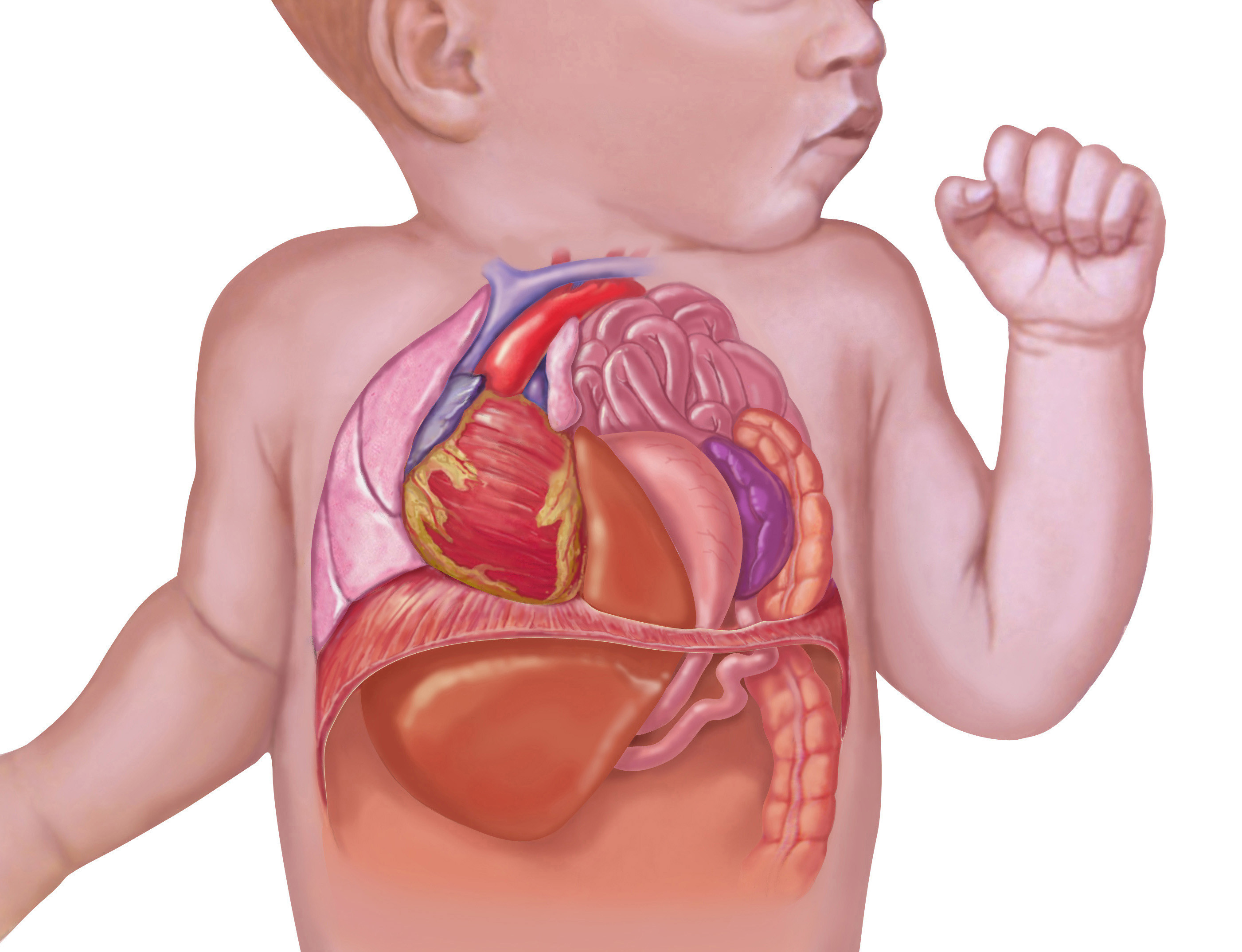Definisi
Diafragma adalah otot berbentuk kubah yang membatasi rongga dada dan rongga perut. Diafragma memisahkan jantung dan paru dari organ perut seperti lambung, usus, limpa, dan hati.
Hernia diafragma terjadi ketika satu atau lebih organ perut terdorong ke rongga dada melalui lubang atau bukaan pada diafragma. Lubang ini dapat muncul sejak lahir atau didapat di kemudian hari. Hernia diafragmatika selalu menjadi keadaan darurat medis dan memerlukan pembedahan segera untuk memperbaiki bukaan tersebut.
Para peneliti memperkirakan bahwa sekitar 1 dari 3.600 bayi lahir dengan hernia diafragmatika di Amerika Serikat. Sekitar setengah dari semua bayi baru lahir yang menderita hernia diafragmatika juga memiliki kelainan lain, termasuk kelainan bawaan lahir pada otak, jantung, dan usus.
Penyebab
Berdasarkan sebab dan waktu terbentuknya, hernia diafragmatika dibagi menjadi 2 jenis, yaitu hernia diafragmatika kongenital (CDH) yang terjadi sebagai bawaan lahir dan hernia diafragmatika didapat (ADH).
Hernia diafragmatika kongenital disebabkan oleh perkembangan diafragma yang tidak normal saat perkembangan janin pada masa kehamilan. Kelainan bawaan pada diafragma janin memungkinkan satu atau lebih organ perut seperti usus, lambung, organ hati, pankreas, dan limpa, untuk bergerak masuk ke dada dan mengisi ruang tempat paru seharusnya berada. Akibatnya, paru tidak berkembang dengan baik, timbul tekanan darah tinggi pada Pada sebagian besar kasus, hernia diafragmatika hanya memengaruhi satu paru.
Hernia diafragmatika didapat biasanya terjadi pada orang dewasa yang mengalami trauma tumpul atau tajam. Kecelakaan lalu lintas dan jatuh menjadi sebab tersering trauma tumpul. Sementara itu, trauma benda tajam biasanya disebabkan oleh luka tusuk atau luka tembak. Prosedur pembedahan pada area perut atau dada juga dapat menyebabkan kerusakan yang tidak disengaja pada diafragma. Pada kasus yang jarang, hernia diafragma dapat terjadi tanpa sebab yang pasti dan tidak disadari dalam jangka waktu tertentu sampai berkembang menjadi cukup parah untuk menimbulkan gejala.
Faktor Risiko
Sebagian besar hernia diafragmatika kongenital bersifat idiopatik, yaitu tidak diketahui penyebabnya secara pasti. Diyakini terdapat beberapa faktor yang berperan pada berkembangnya hernia diafragmatika kongenital. Kelainan kromosom dan genetik, paparan faktor lingkungan, serta gangguan nutrisi memiliki peran dalam pembentukan hernia. Hernia diafragmatika juga dapat terjadi bersamaan dengan masalah organ lain seperti kelainan perkembangan jantung, saluran cerna, atau sistem genital dan saluran kemih.
Semetara, faktor-faktor berikut dapat meningkatkan risiko hernia diafragma yang didapat:
- Trauma tumpul karena kecelakaan lalu lintas
- Prosedur pembedahan pada dada atau perut
- Jatuh yang mempengaruhi area diafragma
- Luka tusuk
- Luka tembak
Gejala
Tingkat keparahan gejala hernia diafragmatika bervariasi tergantung pada ukuran dan penyebab hernia, serta organ yang terlibat. Gejala tersebut antara lain:
- Kesulitan bernapas yang disebabkan karena perkembangan paru yang abnormal. Pada hernia diafragma didapat, sulit bernapas terjadi ketika paru tidak dapat mengembang dengan baik saat bernapas. Gangguan fungsi paru ini terjadi karena fungsi paru yang terdesak oleh organ perut.
- Takipnea (pernapasan cepat), yang terjadi karena paru akan mencoba mengkompensasi rendahnya kadar oksigen dalam tubuh dengan bekerja lebih cepat.
- Perubahan warna biru pada kulit (sianosis) yang terjadi etika tubuh tidak menerima cukup oksigen dari paru.
- Takikardia (denyut jantung cepat) karena kurangnya oksigen dalam tubuh membuat jantung berusaha memompa darah lebih cepat dari biasanya.
Diagnosis
Dokter biasanya dapat mendiagnosa hernia diafragmatika kongenital sebelum bayi lahir. Sekitar setengah kasus ditemukan saat pemeriksaan ultrasonografi (USG) kehamilan. Pada USG, akan ditemukan adanya gangguan pada paru dan kelainan pada diafragma janin, serta peningkatan jumlah cairan ketuban (cairan yang mengelilingi dan melindungi janin) di dalam rahim ibu.
Setelah lahir, gejala dan kelainan berikut dapat terlihat pada pemeriksaan fisik yang dilakukan oleh dokter:
- Pergerakan perut bayi yang tidak normal
- Kesulitan bernapas dan terlihat usaha bernapas yang keras dari pergerakan dinding dadanya
- Perubahan warna biru pada kulit
- Hilangnya suara napas pada satu sisi dada
- Suara usus terdengar di dada
- Teraba perut "tidak penuh"
Pemeriksaan lainnya yang juga dapat dilakukan untuk menunjang diagnosa hernia diafragma adalah:
- Pemeriksaan pencitraan dengan sinar X-ray, USG dada dan perut, CT (Computed Tomography) scan, dan MRI (Magnetic Resonance Imaging)
- Tes gas darah arteri untuk memeriksa kadar oksigen, karbon dioksida, dan keasaman (pH) dalam tubuh
Tata Laksana
Baik hernia diafragmatika kongenital maupun yang hernia didapat memerlukan pembedahan segera. Prosedur pembedahan harus dilakukan untuk mengeluarkan organ perut dari dada dan mengembalikannya ke perut. Dokter bedah kemudian akan memperbaiki diafragma yang cacat.
Pada CDH, dokter bedah akan melakukan operasi sedini mungkin dalam kurun waktu 48-72 jam setelah bayi lahir. Pembedahan dapat dilakukan lebih awal pada kondisi darurat atau mungkin ditunda pada kondisi tertentu. Langkah pertama adalah menstabilkan bayi dan meningkatkan kadar oksigennya. Berbagai obat dan teknik digunakan untuk menstabilkan bayi dan membantu pernapasan. Bayi-bayi ini sebaiknya dirawat di bagian Neonatal Intensive Care Unit (NICU), yaitu bagian khusus bayi baru lahir yang memerlukan perawatan dan pemantauan ketat. Setelah bayi stabil, maka prosedur operasi dapat dilakukan.
Pada ADH, pasien juga perlu distabilkan sebelum operasi. Karena sebagian besar kasus ADH disebabkan oleh cedera, mungkin terdapat juga komplikasi lain seperti pendarahan organ dalam yang juga merupakan kondisi gawat darurat. Oleh karena itu, operasi harus dilakukan sesegera mungkin.
Komplikasi
Operasi memperbaiki hernia diafragmatika memiliki beberapa komplikasi. Komplikasi yang dapat terjadi setelah operasi antara lain hipertensi paru (peningkatan tekanan pembuluh darah paru) berulang serta penurunan mekanisme pernapasan dan pertukaran gas. Komplikasi yang jarang timbul namun bisa terjadi meliputi kekambuhan CDH, yang sering terjadi setelah prosedur perbaikan lubang pada hernia diafragmatika; bocornya cairan perut dan darah ke dalam dada; serta terbentuknya hidrotoraks, yaitu penumpukan cairan abnormal pada rongga pleura pembungkus paru. Penyumbatan usus halus juga dapat terjadi akibat usus menjadi lengket atau terpuntir.
Pencegahan
Saat ini, belum ditemukan cara untuk mencegah CDH pada masa kehamilan. Pemeriksaan kehamilan yang teratur penting dilakukan untuk mendeteksi masalah kesehatan pada janin sebelum dilahirkan. Hal ini memungkinkan perencanaan dan perawatan yang tepat sebelum, selama, dan setelah melahirkan.
Beberapa tindakan pencegahan untuk menghindari ADH meliputi:
- Mengemudi dengan aman dan menggunakan sabuk pengaman saat mengendarai mobil
- Menghindari aktivitas yang membuat Anda rentan terkena cedera tumpul pada bagian dada atau perut, seperti olahraga yang ekstrim
- Menghindari alkohol dan penggunaan obat-obatan yang membuat Anda lebih rentan mengalami kecelakaan
- Berhati-hatilah saat berada di sekitar benda tajam, seperti pisau atau gunting
Kapan Harus ke Dokter?
Temui dokter jika Anda memiliki tanda atau gejala hernia diafragmatika seperti yang disebutkan di atas. Penanganan yang tepat dan segera dapat meningkatkan peluang kesembuhan dan mencegah komplikasi.
Mau tahu informasi seputar penyakit lainnya? Cek di sini, ya!
- dr Hanifa Rahma
Khalid, R. (2017). Diaphragmatic hernia. Retrieved January 3, 2022, from https://www.healthline.com/health/diaphragmatic-hernia.
Lewis, N. (2021). Diaphragmatic hernias: treatment & management. Retrieved January 3, 2022, from https://emedicine.medscape.com/article/934824-treatment#d1.
Centers for Disease Control and Prevention (2020). Diaphragmatic hernia. Retrieved January 3, 2022, from https://www.cdc.gov/ncbddd/birthdefects/diaphragmatichernia.html.
Mayo Clinic Staff (2021). Hiatal hernia. Retrieved January 3, 2022, from https://www.mayoclinic.org/diseases-conditions/hiatal-hernia/symptoms-causes/syc-20373379.
Khatri, M. (2021). Hiatal hernia. Retrieved January 3, 2022, from https://www.webmd.com/digestive-disorders/hiatal-hernia.












